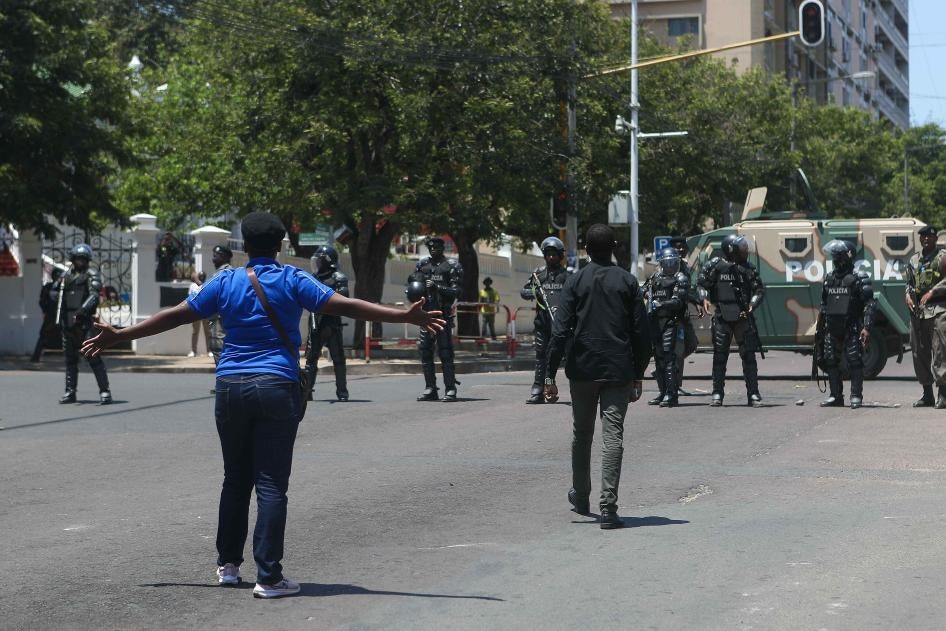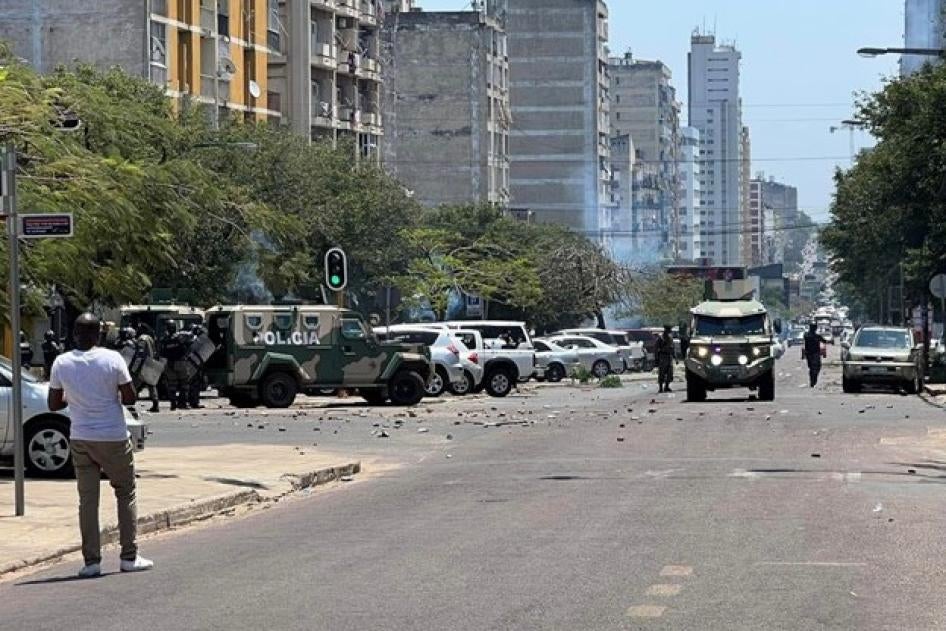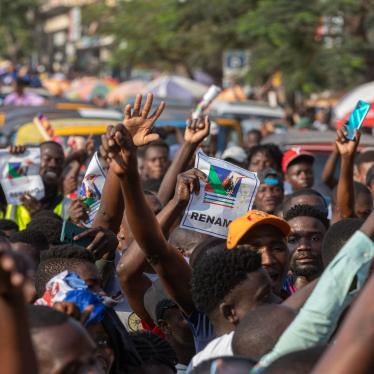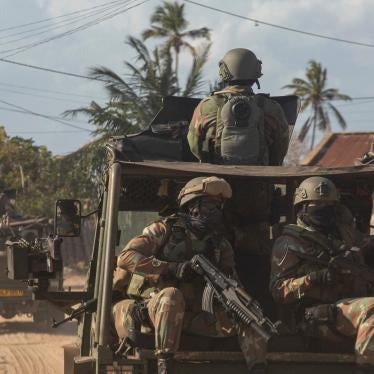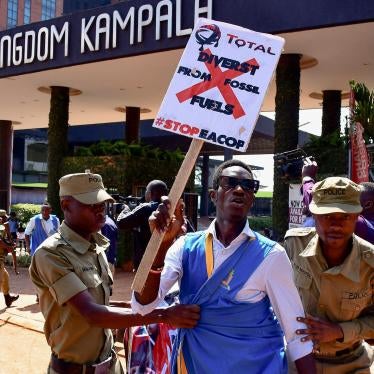(Johannesburg) – Mozambican security forces have used excessive force, including live ammunition, rubber bullets, and tear gas, against largely peaceful protesters following local elections, Human Rights Watch said today. The media reported at least three people were fatally shot, including a 10-year-old boy on his way back from school in Nampula province.
Protesters took to the streets on October 27, 2023, after the main opposition party, Mozambican National Resistance (RENAMO), called for nationwide demonstrations, following the Election Commission’s announcement that the ruling Liberation Front of Mozambique (FRELIMO) had won in 64 of the country’s 65 municipalities. Court decisions found irregularities in the voting on October 11.
“Mozambican forces once again used lethal force during protests and the result is the death of a 10-year-old boy and others,” said Ashwanee Budoo-Scholtz, deputy Africa director at Human Rights Watch. “The authorities need to promptly investigate why security forces opened fire, prosecute those responsible for wrongdoing, and take steps to avoid further bloodshed, including training the police on managing protests.”
On the morning of October 27, thousands of opposition members and supporters gathered at Workers Square in Maputo, the capital. They planned to march to the Constitutional Council to demand it should not validate the election results announced on October 26. It is not clear if the organizers communicated the march route to the authorities, as the law requires.
The RENAMO mayoral candidate for Maputo, Venancio Mondlane, led the march. As the marchers passed through some of the main streets of Maputo, the crowd chanted “Povo no poder” (power to the people), a song by the late Mozambican rapper Azagaia, and shouted “FRELIMO, fora” (FRELIMO out). Half an hour into the march, the crowd met heavily armed riot policemen and five armored vehicles blocking the two lanes of 24 de Julho Avenue, several people told Human Rights Watch.
A RENAMO official told Human Rights Watch the police ordered the demonstrators not to use that route, which leads to an area close to the president’s residence, and to immediately disperse. Without waiting for people to follow the orders and without warning, the officers fired tear gas into the crowd and fired guns into the air. Human Rights Watch viewed footage of people covering their mouths and noses as they ran away, with sounds of gunshots in the background.
“When they [police] begun to fire at the crowd, we all ran for our lives,” said a young man. “We were running from bullets and from plainclothes police officers who emerged in the crowd.”
Human Rights Watch monitored developments via a live feed on social media and saw riot policemen fire in the air and use teargas against the crowd to disperse them. Smaller groups of young men who left the crowd were later seen burning tires, blocking road access in the city, and throwing stones at police positions.
Police also used excessive force in the northern province of Nampula, including live ammunition, rubber bullets, and tear gas against demonstrators. The demonstrators used stones, and burning tires to block roads and were seen destroying private property in the cities of Nampula and Nacala Porto. A woman told a local newspaper the city of Nampula looked like a “war zone” and “gunshots could be heard across the city” since early morning. At least three people were killed, including the 10-year-old boy, a market seller, and a police officer. Human Rights Watch was unable to get the names of the victims.
A prominent civil society group, Centre for Public Integrity, said a stray bullet struck the boy while he was on his way back from school. Human Rights Watch saw footage shared by another local group, the Centre for Democracy and Human Rights, which showed people carrying what appeared to be the market seller’s body. Several people were injured, at least nine from gunshots, according to the Nampula Central Hospital. One of the injured was a 12-year-old boy who had four gunshot wounds, a hospital official told the media.
Human Rights Watch contacted a spokesman for the police in Maputo city, Leonel Muchina, who said they were preparing an official statement for the public. Another spokesman for the police in Nampula city, Zacarias Nacute, confirmed the incidents without providing details, and later, in a news conference, accused the opposition of allowing children to join the protests, making them potential targets.
He said: “At some point, situations may have occurred in which citizens did not comply with the guidelines issued by the police force on the ground to guarantee public order and security, leading [police] to use force, and in that moment, the incident that led to the injury of the minor may have occurred.”
The United Nations Basic Principles on the Use of Force and Firearms by Law Enforcement Officials states security forces must use the minimum necessary force at all times. In dispersing assemblies, they may only use firearms when other less harmful means are not practicable. But the security forces must still use them to the minimum extent necessary. Law enforcement officers may only intentionally make lethal use of firearms when strictly unavoidable to protect life.
The African Commission on Human and Peoples’ Rights emphasizes the use of force is an exceptional measure. The African Commission further states force should only be used as a last resort when it is unavoidable to protect life and should be proportionate and necessary.
The 2020 UN Guidance on Less-Lethal Weapons in Law Enforcement provides that tear gas should only be employed when necessary to prevent further physical harm and should not be used to disperse nonviolent demonstrations. Tear gas should only be used after a warning is given and participants have been given time to obey the warning and provided with a safe space or route for them to move.
“The post-election violence in Mozambique shows that the security forces are set to silence opposition voices rather than to exercise restraint,” Budoo-Scholtz said. “Mozambique’s regional and international partners should meaningfully press for accountability for these abuses so that the government will prevent future violations.”
